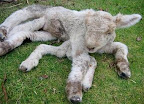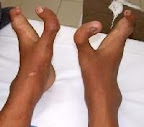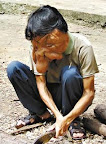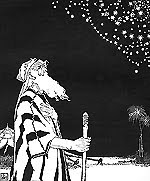
The blind belief in homogeneous reality entails the externalization of aberration and the rejection of anomalies, being these considered meaningless. In many cultures, there is a tendency to regard exceptions to the rule (and especially those which cannot be explained) as something uninteresting. Aberrations are not questioned. Nor is their value in throwing light upon the nature of the systems from which they have been excluded. Anomalies are not considered valuable sources of information about the usual or the ordinary. In this way, problems are externalized and remain outside the area of investigation.[1]

Unusual as they are, the cases to be considered necessarily involve abnormality or aberration. Yet, it is hard to determine whether the so-called anomalous cases are in fact "accidents" of Nature or some of Her "caprices." Nevertheless, the cases in the present study can be ANOMALIES OF NATURE.
Definition of ANOMALY. n [C] 1. Something strange and unusual. 2. Something out of the ordinary, very different from what is expected, or deviating from the usual type or norm. 3. An unusual irregularity or disproportion.
A CLASSIFICATION OF REAL-LIFE ANOMALIES
1. EMBRYOLOGY
1a. Bifurcation (conjoined twins)
 1. A two-headed marine fossile, conjoined twins, a two-headed turtle, and a two-faced kitten.
1. A two-headed marine fossile, conjoined twins, a two-headed turtle, and a two-faced kitten.
 2. Conjoined turtles, a case known as "Pushmepullyou."
2. Conjoined turtles, a case known as "Pushmepullyou."
1b. Excess
 3. Ducklings with three and four legs.
3. Ducklings with three and four legs.
 4. Two cases of human polydactyly, a seven-legged lamb, and an eight-legged frog.
4. Two cases of human polydactyly, a seven-legged lamb, and an eight-legged frog.
1c. Lack
 5. Two cases of split foot malformation or ectrodactily of feet (previously called "lobster-claw malformation") and a one-eyed kitten (holoprosencephaly).
5. Two cases of split foot malformation or ectrodactily of feet (previously called "lobster-claw malformation") and a one-eyed kitten (holoprosencephaly).
2. PATHOLOGY
 6. Joseph Carey Merrick ("The Elephant Man"), London, 1888; Ou Guifeng ("Elephant Man," growing numbers of tumours led to his right eye nearly blind, face twisted, liver impaired, and leg lame), Guangxi Zhuang, China, 2006; and Dede ("Tree Man," displaying tree-like growths that cover his body, as he suffers from human papilsloma virus), Tanjung Jaya, Indonesia, November 2007.
6. Joseph Carey Merrick ("The Elephant Man"), London, 1888; Ou Guifeng ("Elephant Man," growing numbers of tumours led to his right eye nearly blind, face twisted, liver impaired, and leg lame), Guangxi Zhuang, China, 2006; and Dede ("Tree Man," displaying tree-like growths that cover his body, as he suffers from human papilsloma virus), Tanjung Jaya, Indonesia, November 2007.
"
There are no Grotesques in nature" (Browne).[2]
According to Dante Alighieri, "Nature is the art of God."[3] Yet, one wonders whether His Art encompasses all aspects of Nature. Since medieval times, the existence of atypical beings was exploited to establish some sort of didactic contrast: as evil was necessary to understand good, and so was the exception to explain the rule. Medieval tradition saw the anomalous as the artifice of Satan, associating the malformed and the distorted with evil. From the Renaissance on, this approach was counterbalanced by scientific research. Based on the observation of Nature, modern research explained the anomalous as the result of irregular embryonic development (genetics) or rare maladies (pathology).
 7. A comparison: Joseph Carey Merrick ("The Elephant Man"), London, 1888; and "Male Normal Figure" (Prof. Dr. C.H. Stratz, Die Schönheit des weiblichen Körpers (The Beauty of the Female Body), Stuttgart: Ferdinand Enke, 1922, p. 87, fig. 50: "Männliche Normalgestalt"; Openbare Bibliotheek, Amsterdam; Keen Kalderbach).
7. A comparison: Joseph Carey Merrick ("The Elephant Man"), London, 1888; and "Male Normal Figure" (Prof. Dr. C.H. Stratz, Die Schönheit des weiblichen Körpers (The Beauty of the Female Body), Stuttgart: Ferdinand Enke, 1922, p. 87, fig. 50: "Männliche Normalgestalt"; Openbare Bibliotheek, Amsterdam; Keen Kalderbach).
"There is nothing so evil, savage, and cruel in nature as the normal man" (Hesse).[3]
"How protean are the devices available to human intelligence when it lends itself to the persistence of the conformist error" (Lindner).[5]
Notes
1. Paraphrase of "
Blind Belief in a Homogeneous Reality,"
Union of International Associations (15.12.07).
2. Sir Thomas Browne,
Religio Medici (1645), pt. 1, sect. 15: "
Natura nihil agit frustra, is the onely indisputed axiome in Philosophy. There are no
Grotesques in nature; not any thing framed to fill up empty cantons, and unnecessary spaces" (James Eason,
Religio Medici, facsimile version, University of Chicago, 2001, p. 28, sect. 15; 13.12.07. The Latin expression
Natura nihil agit frustra means "Nature does nothing in vain." The term
cantons stands for "corners." In his
Annotations upon Religio Medici, Thomas Keck considers Michel Eyquem de Montaigne,
Essais (1580), bk. 3, ch. 1: «
il n'y a rien d'inutil en nature » (
Annotations, K33-K34; 13.12.07). According to George Seddon, Browne believes that nature does nothing in vain because it fulfils God's purposes (
Landprints: Reflections on Place and Landscape, Cambridge UP, 1997, p. 8 ). See also Alexander F. Chamberlain, "Proverbs in the Making: Some Scientific Commonplaces. II,"
The Journal of American Folklore, Vol. 17, No. 67 (October-December 1904), pp. 268-78, proverb 358; "The Ideal Library, Selected by Dr. Eliot, The Religio Medici of Sir Thomas Browne, Religon of a Physician, Written for His Diversion, Nearly Three Centuries Ago,"
The Sunday Times, 8 August 1909, Magazine Section, p. SM10 (
The New York Times Archives, 13 December 2007; 13.12.07); Alister E. McGrath,
Christian Literature: An Anthology, Oxford: Blackwell, 2001, p. 431; and Zakiya Hanafi,
The Monster in the Machine: Magic, Medicine, and the Marvelous in the Time of the Scientific Revolution, Durham: Duke UP, 2000, pp. 4-5.
3. Dante Alighieri,
On World Government (c.1313), 1.3: "
La natura e l'arte di Dio."
4. Hermann Hesse (1877-1962),
Reflections, 114 (ed. Volker Michels, 1974).
5. Robert Mitchell Lindner,
Must You Conform?, 1956.
Ref. > ANOMALOUS SIDES OF NATURE > REAL BEINGS > NON FICTION > ORIGINAL RESEARCH: DECEMBER 2007 > REVISED AND UPDATED: JUNE 2011.
References and credits
Two-headed turtle, "Janus", born September 1997, Museum of Natural History, Geneva, September 2007 (Fabrice Coffrini/AFP). The animal developed its unusual anatomy while still in the egg. The embryo began to split in two in the process that gives rise to identical twins, but then failed to fully separate. Uncommon, abnormalities caused by incompletely split embryos occur in many animal species, including human beings; the phenomenon leads to what are known as Siamese, or conjoined, twins.

Two-faced kitten, June 2000 (Sandra Pyatt)

Two-headed marine reptile fossil (Hyphalosaurus lingyuanensis), from Yixian Formation, China, December 2006. Shenzen Museum, China (bbc.co.uk / Ker Than, Jianjun Li and Eric Buffetaut, Live Science)

Conjoined red slider turtles, a "pushmepullyou" case, East Norriton, Pennsylvania, U.S., September 2007 (China Daily/AP)

Conjoined twins, New Delhi, India, July 2003 (AFP/Prakash Singh); types

Eight-legged frog, Quanzhou, China, February 2007 (ABC News/AP)

Three-legged duckling, Tancheng County, China, September 2007 (China Daily/Newsphoto)

Seven-legged lamb, South Island, New Zealand, July 2007 (Susan Sandys/Ashburton Guardian/AP)

Case of foot polydactyly (Dr Mark Hill, Embryology, University of New South Wales, Sydney)

Case of hand polydactyly (Dermatology Online Journal)

Four-legged duckling, "Stumpy", New Forest, Hampshire, England, February 2007 (dailymail.co.uk)

One-eyed kitten (holoprosencephaly), Oregon, U.S., December 2005 (ABC News/Traci Allen/AP)

Case of split foot malformation (ectrodactyly of feet), previously called "lobster-claw malformation" (Dr Mark Hill, Embryology, University of New South Wales, Sydney)

Cases of split foot malformation, Africa, [October 2006] (Geocities).

A case of split foot malformation, October 2006 (Xenomed)

Ou Guifeng, 22, nicknamed "Elephant Man", Guangxi Zhuang, China, September 2006. Growing numbers of tumours led to his right eye nearly blind, face twisted, liver impaired, and leg lame (English People Daily)

Joseph Carey Merrick, "The Elephant Man", photograph, London, 1888.

Dede, nicknamed "Tree Man", Tanjung Jaya, Indonesia, November 2007. Tree-like growths cover his body. He suffers from Human Papilsloma Virus (SkyNews)


"Male Normal Figure." Prof. Dr. C.H. Stratz, Die Schönheit des weiblichen Körpers, (The Beauty of the Female Body), Stuttgart: Ferdinand Enke, 1922, p. 87, fig. 50: "Männliche Normalgestalt" (Openbare Bibliotheek, Amsterdam; Keen Kalderbach)




































